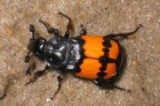
Nicrophorus vespilloides
Encyclopedia
Nicrophorus vespilloides is a burying beetle
described by Johann Friedrich Wilhelm Herbst
in 1783.
Besides the many interesting behavior
s this beetle exhibits, it is of interest because in North America it is restricted to Sphagnum bogs and marsh
es, whereas in Europe and throughout the Palearctic it is found in open forest
habitats. The restriction of N. vespilloides to bogs in the North America has been attributed to competition with its congener, N. defodiens
which in this area is found in forest habitats. N. vespilloides reproduces exclusively in bogs in North America and is never found in adjacent (<100 m or 328.1 ft) forested habitat in the Mer Bleue bog area near Ottawa
, Ontario, Canada.
There are also a number of phoretic
(hitch-hiking) mite
s that are associated with N. vespilloides. These include Pelzneria nr. crenulata, Macrocheles merderius, and Uroobovella nr. novasimilis and the largest mite Poecilochirus carabi. P. carabi is not attached by any physical means (such as a secreted anal stalk in the case of M. merderius) to N. vespilloides. When the males or females of N. vespilloides have finished breeding on a carcass the deutonymphs of P. carabi roam freely about the body of the beetles as they search for new carcasses to reproduce. It had been proposed that P. carabi deutonymphs, on arrival at a new carcass dismounted from the beetles and consumed fly eggs and larvae which would have competed for the beetle larvae for food. This relationship which benefited the beetles has been described as mutualistic
. However, it has been shown that adults of P. carabi consume the eggs of N. vespilloides and that this has direct and negative effects on the reproduction of this beetle species.
Burying beetle
Burying beetles or sexton beetles are the best-known members of the family Silphidae . Burying beetles are true to their name. Most of these beetles are black with red markings on the elytra . They bury the carcasses of small vertebrates such as birds and rodents as a food source for their larvae...
described by Johann Friedrich Wilhelm Herbst
Johann Friedrich Wilhelm Herbst
Johann Friedrich Wilhelm Herbst was a German naturalist and entomologist from Petershagen, Minden-Ravensberg....
in 1783.
Besides the many interesting behavior
Behavior
Behavior or behaviour refers to the actions and mannerisms made by organisms, systems, or artificial entities in conjunction with its environment, which includes the other systems or organisms around as well as the physical environment...
s this beetle exhibits, it is of interest because in North America it is restricted to Sphagnum bogs and marsh
Marsh
In geography, a marsh, or morass, is a type of wetland that is subject to frequent or continuous flood. Typically the water is shallow and features grasses, rushes, reeds, typhas, sedges, other herbaceous plants, and moss....
es, whereas in Europe and throughout the Palearctic it is found in open forest
Forest
A forest, also referred to as a wood or the woods, is an area with a high density of trees. As with cities, depending where you are in the world, what is considered a forest may vary significantly in size and have various classification according to how and what of the forest is composed...
habitats. The restriction of N. vespilloides to bogs in the North America has been attributed to competition with its congener, N. defodiens
Nicrophorus defodiens
Nicrophorus defodiens is a burying beetle described by Mannerheim in 1846.-References:http://collections2.eeb.uconn.edu/nicroweb/PDFs/Sikes_et_al_2002.pdf...
which in this area is found in forest habitats. N. vespilloides reproduces exclusively in bogs in North America and is never found in adjacent (<100 m or 328.1 ft) forested habitat in the Mer Bleue bog area near Ottawa
Ottawa
Ottawa is the capital of Canada, the second largest city in the Province of Ontario, and the fourth largest city in the country. The city is located on the south bank of the Ottawa River in the eastern portion of Southern Ontario...
, Ontario, Canada.
There are also a number of phoretic
Phoresis (biology)
In biology, the term phoresis is an inter-species biological interaction in ecology and refers to a form of symbiosis where the symbiont, termed as the phoront, is mechanically transported by its host. Neither organism is physiologically dependent on the other.Examples may be found in the...
(hitch-hiking) mite
Mite
Mites, along with ticks, are small arthropods belonging to the subclass Acari and the class Arachnida. The scientific discipline devoted to the study of ticks and mites is called acarology.-Diversity and systematics:...
s that are associated with N. vespilloides. These include Pelzneria nr. crenulata, Macrocheles merderius, and Uroobovella nr. novasimilis and the largest mite Poecilochirus carabi. P. carabi is not attached by any physical means (such as a secreted anal stalk in the case of M. merderius) to N. vespilloides. When the males or females of N. vespilloides have finished breeding on a carcass the deutonymphs of P. carabi roam freely about the body of the beetles as they search for new carcasses to reproduce. It had been proposed that P. carabi deutonymphs, on arrival at a new carcass dismounted from the beetles and consumed fly eggs and larvae which would have competed for the beetle larvae for food. This relationship which benefited the beetles has been described as mutualistic
Mutualism
Mutualism is the way two organisms of different species biologically interact in a relationship in which each individual derives a fitness benefit . Similar interactions within a species are known as co-operation...
. However, it has been shown that adults of P. carabi consume the eggs of N. vespilloides and that this has direct and negative effects on the reproduction of this beetle species.

